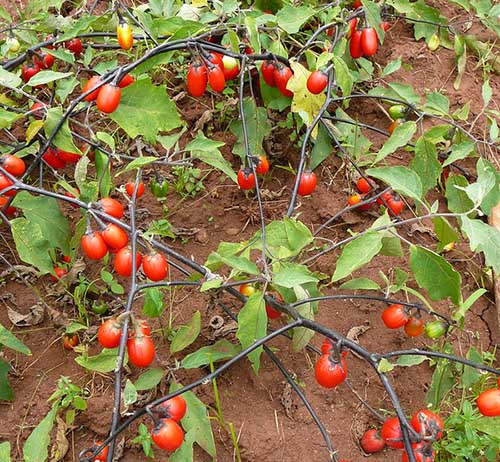You might have heard about African superfoods like moringa, baobob, and hibiscus, all of which are very trendy now for their health benefits. But there are many other African superfoods which have yet to become popular in the West.
Here are some of the most interesting African superfoods. Let me know if I missed any important ones!
1. Mongongo Nuts

Native to Namibia and Botswanna, mongongo nuts grow in a green fuzzy tree fruits. The fruit (but not the skin) is edible and somewhat tastes like dates. The nuts inside are creamy and delicious.
About 50% of mongongo nuts is oils, including healthy essential fatty acids. These fatty acids are great for fighting inflammation and the oil is often used for skin and hair.
2. Kenkiliba

Kenkiliba is finally starting to get some attention around the world. The superfood comes from shrub which grows in West Africa. The leaves are used to make a medicinal tea that has numerous health benefits ranging from fighting inflammation to helping with gallstones. Read more about Kenkiliba here.
3. Ogbono Seeds

The seeds of the ogbono tree (Irvingia gabonensis) are used to make a traditional Nigerian Igbo soup. These seeds are rich in essential fatty acids and minerals like calcium. Some studies have looked into ogbono for helping with weight loss. It’s also called dika and bush mango.
4. Fonio

Digitaria exilis, also known as fonio or acha, is a grain that grows in West Africa. It is similar to millet and has a nice nutty flavor. Because it is gluten-free, it is gaining popularity as an alternative to quinoa. Fonio also boasts amino acids and are great for diabetics.
5. African Eggplant (Solanum aethiopicum)

Also called bitter tomato or nakati, Solanum aethiopicum grows in tropical parts of Africa. It is particularly popular in Cameroon, Uganda and Nigeria. All parts of the plant are edible and have superfood properties.
The leaves are especially rich in retinol, which is important for eye health. Thus, African eggplant has been researched for treating cataracts and glaucoma. Both the fruit and leaves contain antioxidants with anti-inflammatory properties. The roots are used medicinally to treat stomach ailments and high blood pressure.
6. Spider Wisp (Cleome gynandra)

This plant has many local names, including saget, cat’s whiskers, spider flower, Chinsaga (Kisii), feuilles caya, and mozambé. It is particularly popular in Kenya where it is boiled with milk. The milk helps balance out the bitter, sour taste of spider wisp. The leaves are incredibly rich in beta-carotene, calcium, vitamin E, and iron. It is often given to mothers after giving birth and is used medicinally to treat inflammation diseases.
7. Yams

You probably have heard of yams but you probably didn’t know that yams are a fertility superfood. True yams contain type of phytoestrogen called diosgenin which can improve ovulation. Yams are regularly consumed in parts of Africa for these fertility benefits.
8. Cape Aloe

Cape aloe (Aloe ferox) gets its name because it is native to the Cape Region of South Africa. Like aloe vera, Cape aloe also have many health benefits including laxative and cleansing properties and being good for the skin. However, research shows that Cape aloe has more antioxidant, antimicrobial, and anti-inflammatory properties than Aloe vera. Because of this, Cape Aloe juice has become popular.
9. Jute Mallow (Corchorus olitorius)

Also known as nalta jute, bush okra, krinkrin, molokhia or many other local names, this plant has fibrous leaves. They are incredibly rich in nutrients like beta-carotene, iron, calcium and antioxidants. The high fiber content makes them filling and good for weight loss. Combined with lots of spices and served over rice (as in this jute mallow recipe), it is incredibly delicious albeit a bit slimy.
10. Pumpkin Leaves

Pumpkin leaves are common in many African dishes, including ogbono soup, stews, and sauces. They are called muboora in Zimbabwe and ugu in Nigeria.
Not only are pumpkin leaves edible, but they are also a superfood. Pumpkin leaves are incredibly high in vitamin A, which is particularly good for skin.
11. Slenderleaf (Crotalaria brevidens)

Crotalaria is a genus of plants which includes several edible species as well as some poisonous ones. In Africa, the most popular species is Crotalaria brevidens. It goes by various names including slenderleaf, mitoo, rattlepod, and Ethiopian rattlebox.
Slenderleaf has numerous health benefits which make it a great African superfood. It is rich in nutrients like calcium, vitamin A, zinc and iron. It has potent antioxidants and is used medicinally to treat malaria. It’s also commonly used to treat stomach issues, improve eye health, and boost immunity.
12. Bambara Bean

Bambara is a legume (Vigna subterranean). It grows in the ground like peanuts. The beans are dug up and usually roasted or boiled. Sometimes the beans are milled into flour. They are common in many West African recipes, like Nigerian okpa.
As one researcher wrote of Bambara beans, “The seeds have a good nutrient balance and are a rare example of a complete food. They contain sufficient quantities of proteins, carbohydrates, and lipids to sustain human life.”
The beans are also used medicinally to treat diarrhea, venereal diseases, morning sickness during pregnancy and polymenorrhea (short menstrual cycle).
Have you tried any of these African superfoods? What are ones that I missed? Let us know in the comments.
Resources:
https://www.nature.com/news/the-rise-of-africa-s-super-vegetables-1.17712
https://www.tandfonline.com/doi/abs/10.1080/03670244.1996.9991475
http://www.bioline.org.br/request?nd07022#:~:text=Slenderleaf%20(Crotalaria%20brevidens)%20is%20one,consumed%20%5B3%2C%204%5D.
Image credits:
“sunkpila = bambara bean” (CC BY-NC 2.0) by whaun,
African eggplant (Solanum aethiopicum) =” (CC BY-NC 2.0) by GlobalHort Image Library/ Imagetheque,
“Lục lạc, Sục sạc, Rủng rảng,” (CC BY-ND 2.0) by Hoa Trai Viet Nam,
“Cleome gynandra 3” (CC BY-SA 2.0) by tonrulkens,
Schinziophyton_rautanenii by SAplants, Creative Commons Attribution-Share Alike 4.0 International license.
Kinkeliba bundles to boiled color,by T.K. Naliaka, Creative Commons Attribution-Share Alike 4.0 International,
Ogbono seeds, by GodwinPaya, Creative Commons Attribution-Share Alike 4.0 International license.
Acha (Fonio), Fatima Bukar, Creative Commons Attribution-Share Alike 4.0 International license.
“Big tubers of yam” (CC BY-NC 2.0) by IITA Image Library
“Corchorus olitorius L.” (CC BY-SA 2.0) by Dinesh Valke

